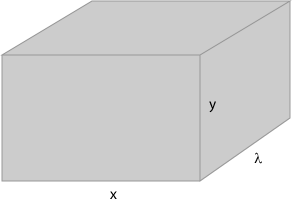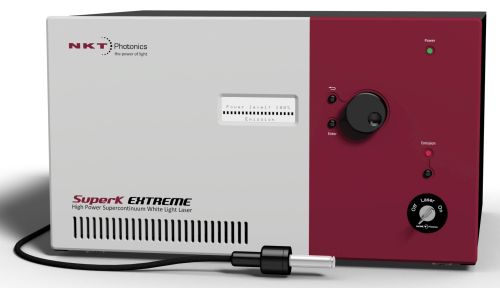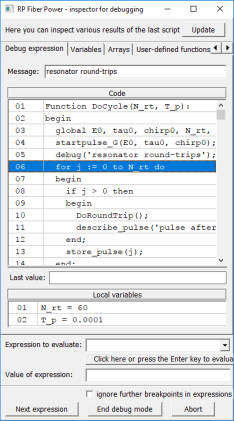Hyperspectral Imaging
Acronym: HSI
Definition: imaging which provides images with an optical spectrum corresponding to each pixel
More general term: imaging
German: hyperspektrale Bildgebung
Category: vision, displays and imaging
How to cite the article; suggest additional literature
Author: Dr. Rüdiger Paschotta
Hyperspectral imaging denotes techniques of advanced spectral imaging, where one obtains a full optical spectrum for each image pixel. In contrast to typical cases of multispectral imaging, one employs a substantial number of different wavelength channels (e.g. hundreds or thousands of them), which are typically more or less equidistant in terms of wavelength or optical frequency, are essentially non-overlapping and cover a substantial contiguous spectral range. The resulting data can be considered to form a hyperspectral cube, i.e., a three-dimensional set of data with coordinates of x, y and λ (wavelength) – see Figure 1.

Each wavelength channel provides a monochromatic two-dimensional image, while one has one optical spectrum corresponding to each point of such an image.
Compared with multispectral imaging, one typically has a substantially larger number of wavelength channels. On the other hand, multispectral imagers can be made to cover larger spectral ranges, for example even including very long infrared wavelengths for thermal imaging – which is hard to realize with image sensors similar to those which are typically used for hyperspectral imagers.
For hyperspectral imaging of nearby objects, one may want to apply spectrally controlled illumination, avoiding influences of variable ambient light. Alternatively, one may apply calibration procedures, which may for example be based on images of reference objects.
Operation Principles of Hyperspectral Imagers
The number of implemented wavelength channels is usually too large for using one type of photodetector per wavelength channel in the image sensor. Therefore, other techniques are typically used:
Point Scanning
One possibility is to employ some kind of spectrometer in conjunction with a 2D scanning imaging device (whisk broom scanner). At any particular time, one receives light from a certain direction and records an optical spectrum. For example, one can use a simple kind of spectrograph with a diffraction grating in front of a one-dimensional photodiode array.
A complete hyperspectral image requires the scanning of all image directions in two dimensions, and typically requires a substantial acquisition time. Also, the use of the incoming light is highly inefficient, and motion artifacts can easily occur.
Although that method allows one to use a quite conventional spectrometer, it is not frequently used due to the mentioned limitations and the need for scanning optics, usually with mechanical parts.
Line Scanning
Line scanning is the most frequently used image acquisition technique for hyperspectral imaging. It means that at any point in time one acquires image information for one line (push broom scanner). The selection of a line is typically done by placing an optical slit in an image plane. Further, one uses a diffraction grating or other dispersive optical element for spatially separating the different wavelength components in the direction perpendicular to the slit. The light can then be sent to a two-dimensional image sensor (focal plane array), where one direction corresponds to a spatial coordinate and the other direction to the wavelength. One may use exchangeable gratings for covering different spectral regions with different spectral resolution.
The completion of an image requires multiple such recordings with different orientations of the mentioned slit, or the whole imaging instrument, or the imaged object. For example, instruments on aircraft or space satellites are naturally moving in one direction, which should be perpendicular to the direction of the image line. Similarly, one can image objects which are moving, for example along a conveyor belt in a factory. In other cases, a moving mirror or other kind of scanning optics is needed for one-dimensional scanning of the viewing direction.
Compared with point scanning, the image acquisition can be much faster, and the tendency for motion artifacts is reduced. The required type of focal plane array is reasonably simple; it just has to exhibit a sufficiently high responsivity over the full wavelength range of interest. The wavelength dependence of the responsivity can be taken into account in the device calibration.
Still, the use of the input light is not very efficient, since only light corresponding to one line can be utilized at one time.
Spectral Scanning
One can realize hyperspectral imaging essentially by integrating a tunable optical bandpass filter into a camera. One then records an image for one wavelength slot at a time and combines the data from many such recordings to a hyperspectral cube. Although light for all image directions can be utilized at all times, one uses only a small spectral slot at any time, so that the efficiency of light usage is similarly low as for line scanning. Also, it is not easy to realize a tunable bandpass filter for high spectral resolution.
Alternatively, one may use wavelength-tunable illumination, for example with an optical parametric oscillator. Each image exposure is done for one wavelengths, and many exposures with different wavelengths provide a hyperspectral image.
A central advantage of spectral scanning is the possibility to use conventional imaging instruments. For example, one may equip a microscope with a suitable filter to perform hyperspectral microscopy.
Another advantage of spectral scanning is the ability to record images for different wavelength channels in arbitrary order. In other words, one does not have to record a complete hyperspectral cube each time, but can select wavelengths according to the specific imaging purpose and situation. For example, one may regularly operate with only a limited set of wavelengths and acquire images at a different wavelength only under certain circumstances, e.g. when certain interesting objects have been detected.
Spatiospectral Scanning
Spatiospectral Scanning is a kind of mixture between spatial and spectral scanning, where each recording with a two-dimensional image sensor represents a diagonal slice of the hyperspectral cube. While one spatial coordinate on the sensor simply corresponds to a spatial coordinate, the second coordinate is wavelength-coded. Scanning in one dimension is required to complete the hyperspectral cube.
Snapshot Imaging
Particularly for applications in astronomy, efficient use of incoming light is essential. Therefore, it is highly desirable to avoid any spatial or spectral scanning by using some kind of snapshot imaging. A substantial number of different technical approaches have been developed for such purposes, and all of them lead to a relatively complex and expensive technical setup.
To give just one example, one may image the scene to the input of a fiber bundle, which is made such that the output fibers are arranged along one line. (There are also other optical arrangements which can do such image slicing.) One can then disperse the different wavelength components in a direction perpendicular to the line and send the light to a two-dimensional image sensor, or to multiple sensors if required for a large number of pixels. In that sense, the operation principle is quite similar to that of a line scanner as explained above. However, one can process a full image at once. It is essential for efficient light collection to have a fiber bundle with high numerical aperture and a high area ratio of the fiber core.
While the explained method requires sophisticated optical elements, it delivers hyperspectral cube data quite naturally. Other methods have been developed where one needs to employ sophisticated data processing algorithms for obtaining such data.
Data Processing and Display
Hyperspectral imaging often produces vast amount of data – little more than can be captured by a human observer without additional instrument features. For viewing such data, one may apply different techniques:
- A simple method is to display monochrome images for variable wavelength channels, which one can dial through with a wheel, for example.
- One may apply false color scales, which however can never show the full spectral content of an image due to limitations of the display and the observer's eye. However, one may apply more or less sophisticated processing techniques, for example for extracting chemical information from the optical spectra. The color scale then shows chemical rather than spectral information.
- In many cases, the obtained image data are not regularly used for viewing, but for automatic processing.
Applications of Hyperspectral Imaging
Some examples for applications of hyperspectral imaging are explained in the following:
- Hyperspectral instruments on satellites are used for various kinds of Earth monitoring from space, for example for geological surveys, for environmental monitoring and for military surveillance. Various wavelengths channels can be used for monitoring vegetation (e.g. agricultural crops), while others are useful for detecting minerals, buildings, etc.
- Smaller regions on Earth can be monitored with instruments on airplanes and drones, which allow for higher spatial resolutions. The purposes can be similar as for satellite instruments, for example monitoring the development of agricultural crops or competing plants.
- Military instruments based on space satellites, aircraft or on the ground can be used for detecting and tracking aircraft and missiles.
- In the quality control of agricultural products, hyperspectral imaging allows for quite a precise identification of faulty products or foreign material, e.g. spoiled nuts or stones. Imaging devices can be combined with computers for sophisticated data processing and actuators for removing unwanted objects; such digital food sorters can be far more efficient than using human personnel.
- In astronomy, hyperspectral imaging is often called 3D spectroscopy or integral field spectroscopy (IFS). Detailed spectral information is often vital for categorizing stars, for example. One mostly uses sophisticated techniques for snapshot imaging in order to utilize the incoming light most efficiently.
- The investigation of ancient pieces of art can profit from detailed spectral information, which may for example reveal the use of certain materials.
Generally, hyperspectral instead of only multispectral data can be beneficial to obtain more specific information on various types of objects. For example, flowers from different plants may appear in quite similar color for the human eye, but can clearly be distinguished with hyperspectral data, having a much higher spectral resolution.
Suppliers
The RP Photonics Buyer's Guide contains 15 suppliers for hyperspectral imaging instruments. Among them:


NKT Photonics
Ideal for hyper spectral imaging, the unique properties of our SuperK EXTREME/FIANIUM broadband white light laser allow you to have a picosecond pulse source at any wavelength in the visible and near-infrared spectrum. Combined with our SuperK VARIA tunable filter, you are effectively turning the SuperK supercontinuum laser into a powerful single-line laser with a 440 nm tuning range and variable bandwidth. The center wavelength of the pass band can be tuned anywhere between 400 and 840 nm and the bandwidths are variable between 10 and 100 nm, making the SuperK VARIA the most flexible filter solution on the market.
Questions and Comments from Users
Here you can submit questions and comments. As far as they get accepted by the author, they will appear above this paragraph together with the author’s answer. The author will decide on acceptance based on certain criteria. Essentially, the issue must be of sufficiently broad interest.
Please do not enter personal data here; we would otherwise delete it soon. (See also our privacy declaration.) If you wish to receive personal feedback or consultancy from the author, please contact him e.g. via e-mail.
By submitting the information, you give your consent to the potential publication of your inputs on our website according to our rules. (If you later retract your consent, we will delete those inputs.) As your inputs are first reviewed by the author, they may be published with some delay.
See also: spectral imaging, multispectral imaging
and other articles in the category vision, displays and imaging
 |




If you like this page, please share the link with your friends and colleagues, e.g. via social media:
These sharing buttons are implemented in a privacy-friendly way!